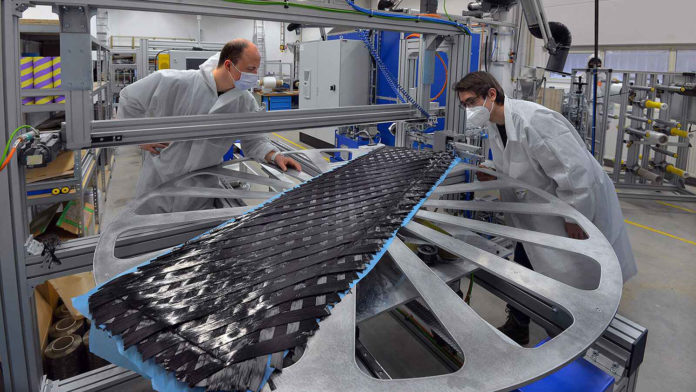Typically, lightweight composite layers of skis and snowboards are made from sheets of interwoven carbon or glass fibers with added resin. These sheets are cut from a roll of material and then cut to required sizes and shapes. This means that scrap material ends up being leftover and is usually just discarded.
Researchers from the Chemnitz University of Technology have developed a very lightweight snowboard that can also be manufactured far more sustainably than comparable boards – with less fiber waste. This is made possible via a variation on an automated technique known as “dry fiber placement.” It involves pulling individual carbon and glass fibers together and laying them directly into a snowboard shape around a wood core. Resin is added when the layers of these fibers are subsequently laminated into a single unit.
This way, all the fibers allocated for one snowboard go into that board. In addition, the quality of the various parts of the board can be adjusted by controlling the way the fibers are laid. For example, they can be tightly packed in some places and more widely spaced in others. With this technique, fiber waste in snowboard production can be reduced by around 60%, researchers said.
The first Chemnitz prototype is actually a splitboard, which can be split into two touring skis for getting up the mountain and then reattached into a single snowboard for going down. With a weight of 2.6 kilograms and a length of 1.59 meters, the splitboard is said to be one of the lightest in the industry.
Additionally, the A.L.D. (Anisotropic Layer Design) technology allows the snowboard edges to deform depending on the riding situation, which noticeably improves the ride. The deformable edges are claimed to increase hold by digging into the snow during a turn.
“On the other hand, during boardslide, a trick in which the snowboarder jumps onto an obstacle with a 90-degree turn and slides over it, the edge manages to lift off the rail,” explains Dr. Jörg Kaufmann, manager of the composites division at the Department of Textile Technologies. “This prevents boards from wearing down and makes it more difficult for them to warp.“
“This not only saves costs but thanks to the board’s sustainable production, its carbon footprint is also significantly reduced,” says Prof. Dr. Holger Cebulla, head of the Chair of Textile Technologies.
